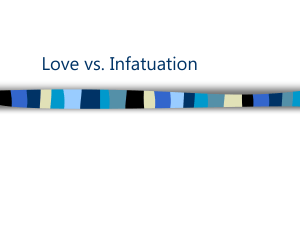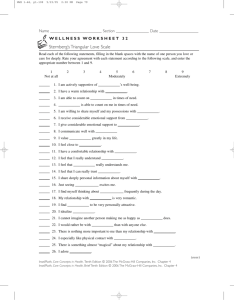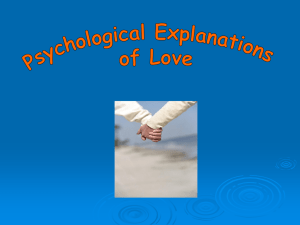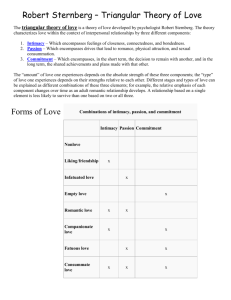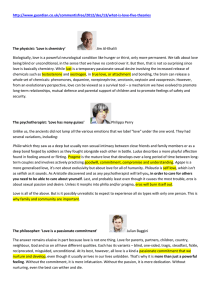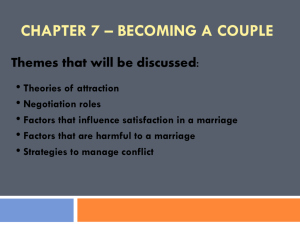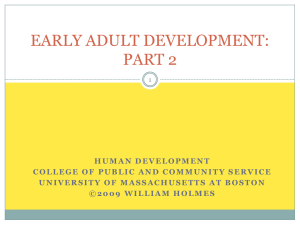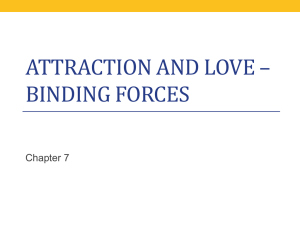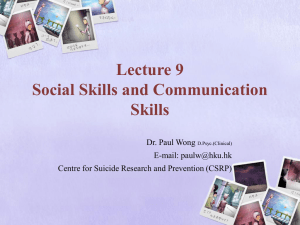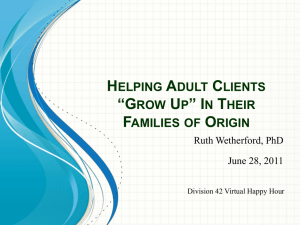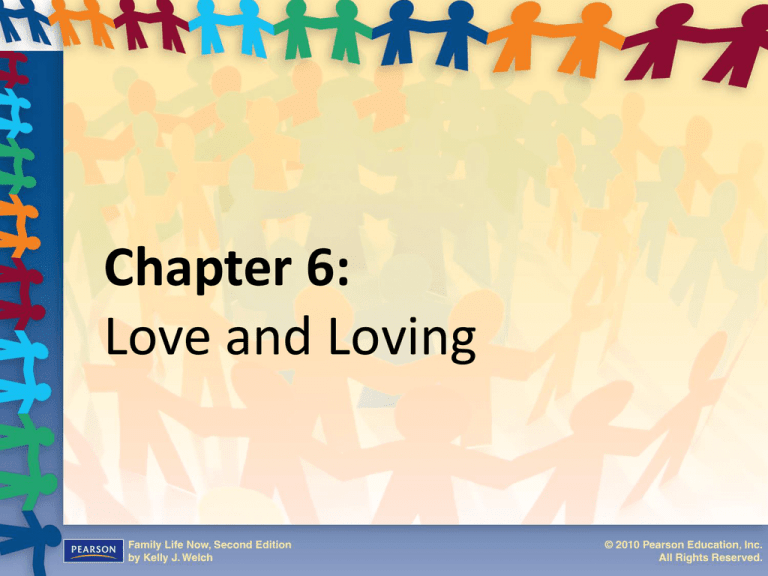
Chapter 6:
Love and Loving
Love is a Cultural Experience
• Collectivist Cultures
– Goals of whole society are given priority over
individual goals
– Members strive to be equal
– Behavior is driven by sense of obligation and
duty
• Latinos value interdependent relationships
• Asians emphasize importance of collective
whole
Love is a Cultural Experience
• Individualist Cultures
– Individual goals are promoted over group goals
• People define their identity by personal
attributes
–Wealth
–Social status
–Education level
– Promote the idea of autonomy and
individuation
History of Love and Romance
• Ancient History
• Examples of love and romance
– Adam and Eve
– Gilgamesh – 2000 BCE
– King Solomon – 970 BCE
• Account of love and romance between bride
and groom
– Greeks – 450 BCE
• Love was bittersweet emotion
History of Love and Romance
• Middle Ages and Renaissance
– True era of romance, courtship
– 16th century love viewed as physical union
• Coming to America
– Puritans were romantic lovers
– Expected sex within marriage
History of Love and Romance
Back in Europe
• Victorian Era (1837-1901)
– Attitudes towards sexuality were stuffy
– Ideal of love promoted couple togetherness
• Romantic Love
– 20th century saw social change
– Emancipation of women
– Romantic attraction became accepted
What is love?
• Greek definitions
– Eros: sexual, physical components
– Philos: brotherly love
– Agape: self sacrificing, spiritual
What is love?
• Love as a prototype – Beverley Fehr
– Prototype is a model
– Twelve central features of love
• Love maps – John Money
– Present an ideal image of love
– Shaped by experiences in infancy and
childhood
Table 6.1: Fehr’s Twelve Central Features
of Love
What is love?
• Passionate love
– Infatuation: intense, extravagant, shortlived passion for the other person
– Simple infatuation: a physical attraction
– Infatuation as Romance
– Romantic infatuation: romantic love
– Foolish, unreasoning passionate attraction
What is love?
• Passionate love
• Intense longing for the selected love object
• Emotional manifestations
– Idealizing the romantic partner
– Intense sexual attraction
– Surge of self confidence
– Adoration of the love interest
– Fatuous relationships end as quickly as they
began
Table 6.2: The
Passionate Love Scale
What is love?
•
•
•
•
•
Infatuation as Limerence
Similar to romantic love
Intrusive thoughts about love object
“Love sick”
Symptoms
– Longing for reciprocation
– Aching for the limerent object
– Intense emotions
What is love?
When limerence ends – three possibilities
• Consummation
– Feelings have been reciprocated or there
is mutual, lasting love
• Starvation
– Limerence is starved out of existence
• Transformation
– Limerence is transferred to new object
Companionate Love
• Deep, mature, affectionate attachment
bonds
• Less dominated by lust
• Develops over time
• Partners accept all of the failing, faults,
shortcomings, etc
• Liking – necessary ingredient
Expression of Love
Triangular theory of love – Sternberg
8 different types of love relationships
Love relationships consist of:
• Passion
• Intimacy
• Commitment
Figure 7.1: Sternberg’s
Triangular Theory of
Love
Expression of Love
• Intimacy
– Feelings of closeness
– Connectedness
– Bondedness
– Self-disclosure
– Respect
– Trust
– Builds slowly over time
Expression of Love
Commitment
– Loving another person and making a
conscious decision to maintain that love
over time
– A deliberate choice
– Being loyal to another individual
Expression of Love
• Passion
– Physical attraction
– Romantic feelings
– Most intense and immediate component
– Sexual consummation
Figure 6.2: Sternberg’s Love Types
Sternberg’s Eight Love Types
1. Nonlove – absence of intimacy,
commitment and passion
2. Empty love – void of passion and intimacy,
commitment is the only element
3. Liking – intimacy is the sole element in this
type, no passion or commitment
4. Infatuated love – consists of passion only,
idealized love, relationships begin and end
quickly
Sternberg’s Eight Love Types
5. Companionate love – combines intimacy
and commitment, intimacy builds
6. Fatuous love – combines passion and
commitment, relationship lacks intimacy
7. Romantic love – intimacy and passion with
sexual attraction and arousal
8. Consummate love – combines all three
elements of love-intimacy, commitment
and passion
Developing Love – First Experience
• Altruistic love – love parents give their child,
promotes the well being of one with no
expectation of reciprocity
• Intrinsic rewards – joy, satisfaction,
contentment, pleasure, gratification
Reciprocity and Love
• Interdependent love – love is a give and take
process, requires give and take and changes
over time
• Attachment – emotional bond that binds a
child to the parent, begins in infancy and
influences personality
Attachment Types
• Secure attachment – maintain close
relationships with one another
• Avoidant attachment – seldom find real love,
uncomfortable when too emotionally or
physically close to another person
• Anxious/Ambivalent attachment – insecure,
constantly afraid partner doesn’t love them
The Genogram
• Used to understand the transmission of
relational behaviors from one generation to
the next
• Diagrams with various figures are used to
illustrate relationships between family
members
Figure
6.4A:
Basic
Genogra
m
Symbols
Figure 6.4B Genogram
Symbols for
Relationship Dynamics
Lee’s Six Types of Love Styles
• Eros – erotic lovers are passionate and
romantic and seek out passionately
expressive lovers
• Ludus – playful, carefree and casual lovers
who do not care as much about commitment
as they do about playing the game of love
Lee’s Six Types of Love Styles
• Storge – love that is based on friendship or
affection between friends, love grows over
time
• Manic – jealous lovers, everything is in
chaos, highs are high and lows are low,
relationships are like a roller coaster ride
Lee’s Six Types of Love Styles
• Pragma – pragmatic, weigh the costs and
benefits of the relationship
• Agape – selfless, enduring, other-centered
love, provides intrinsic satisfaction without
reciprocity
Reiss’s Wheel Theory of Love
Four Processes
1. rapport – establish rapport, usually with
someone like us
2. self-revelation – self-disclosure about goals and
dreams
3. mutual dependency – relationship deepens,
and couple relies on one another
4. Personality need fulfillment – established
pattern of exchange and support
Figure 6.5 Reiss’s Wheel Theory of Love
Love Economic Model
• Based on the assumption that people are
rational decision makers and as a result
compare the costs and benefits of falling in
love and being in love
• Sex and commitment are the only
differences between friendship and love
Table 6.3: Love Economics Translations
Benefits of Love
• Emotional needs
– Self esteem, social needs, spiritual needs
• Entertainment needs
– Social aspects of day-to-day living
• Materialistic needs –
– Required for survival and happiness,
– Food shelter and clothing
Costs of Love
1. Search cost – ability to attract potential
partners
2. Rejection costs – rejection sensitivity,
immunity to rejections and emotional
costs of rejections
3. Maintenance costs – emotional costs and
time costs in finding right person
Costs of Love
4. Breakup risk includes determining the
overall benefits with the partner
5. Breakup costs – emotional costs, financial
costs and the search cost to find someone
else

